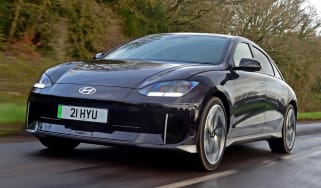Hyundai Ioniq 6 review
The Hyundai Ioniq 6 is a very impressive electric car with a unique look and excellent technology

The Hyundai Ioniq 6 follows on pretty much directly from the Ioniq 5 – our 2021 Car of the Year. It uses the same tech underneath but with a sleeker, saloon shape and slightly sharper handling than its hatchback sibling. Its bold looks aren’t for everyone, but its charging speeds, comfortable interior and excellent in-car tech mean it’s up there with the best electric cars around.
It has a lot of the same strengths as the Ioniq 5, which is actually its biggest downfall. The Ioniq 6 is a bit less practical than its stablemate while also being a little more expensive to buy. But if you love how it looks, the Ioniq 6 is a fantastic car and well worth a look.
About the Hyundai Ioniq 6
The original Hyundai Ioniq was a slightly oddball alternative to the Toyota Prius, but in 2020 the Ioniq name was used to create a sub-brand of EVs within the company’s regular line-up. The first model to arrive was the Ioniq 5 hatchback in 2021, followed by the Ioniq 6 saloon in 2022, and an Ioniq 7 flagship SUV is already in the works.
Dubbed the “electrified streamliner” by Hyundai, the Ioniq 6 draws heavily from the Hyundai Prophecy concept car we fell in love with in 2020. The saloon also takes some of the Ioniq 5’s design cues, such as the square pixel lights and chiselled body lines, and applies them to a much more dramatic silhouette. The result is an incredibly low drag coefficient of just 0.21Cd, and looks that will turn more heads than some supercars.
More reviews
Car group tests
Road tests
The Ioniq 6 uses the same Electric Global Modular Platform (E-GMP) that underpins the Ioniq 5, along with other models such as the Kia EV6 and EV9, and the Genesis GV60. One benefit of the platform is an 800V charging system that allows the Ioniq 6 to charge at up to 220kW, meaning a 10 to 80 per cent top-up from a suitable rapid charger takes just 18 minutes.
Every Ioniq 6 is powered by a 77.4kWh battery that provides a range of up to 338 miles, depending on the model, with buyers given the choice of rear-wheel drive (RWD) or all-wheel drive (AWD). The former uses a single 225bhp electric motor, while the latter has 321bhp on tap but a slightly reduced maximum range.
There are now just two trim levels for buyers to choose from: Premium and Ultimate. All models are very well equipped, with standard kit including 20-inch alloy wheels, two 12.3-inch displays, Apple CarPlay, Android Auto, LED headlights and tail-lights, heated front and rear seats, plus oodles of safety features. Higher-spec cars get extras like digital side mirrors, a Bose sound system and leather upholstery.
Key rivals include the fellow electric saloons like the BMW i4, Polestar 2, BYD Seal and Tesla Model 3 – the facelifted version of which was recently unveiled. The closely related Kia EV6 is another alternative, but perhaps the biggest is Hyundai’s own Ioniq 5, which has most of the same appeal as the Ioniq 6 in a more practical package.

For an alternative review of the Hyundai Ioniq 6, visit our sister site drivingelectric.com...










